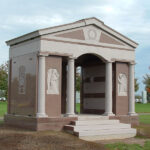Harbeck Mausoleum
- At July 31, 2013
- By mausoleum
- In Doug Keister's Blog
0

John H. Harbeck certainly had an interesting life as well as a contentious life and afterlife. His father, William H. Harbeck, was a founding partner of a substantial warehousing empire on Furman Street in Brooklyn known as the Harbeck Stores. John Harbeck reaped the rewards of that business, made investments of his own including ones in Colorado and railroad stocks, and led a rather opulent life thanks to his comfortable financial situation. In 1870, he met one Caroline Montgomery who claimed she was about to be divorced from her scallywag of a husband, Andrew Montgomery. John’s and Caroline’s hearts soon swooned, and, by 1871, John installed her as his wife at his upscale home on West 55th Street. Caroline was his “wife,” thanks to a far-from-binding oral agreement.
All was reasonably rosy for the usual seven years when Harbeck became enamored of Kate Hammel, a young, pretty, unemployed telegraph operator. Harbeck and Hammel embarked on a clandestine affair and eventually married in early 1880. Caroline didn’t respond favorably to the news and sued Harbeck for divorce. Divorce? Divorce from what? The testy divorce proceedings were covered by the New York Times in multiple floridly detailed stories in the spring of 1882. There was tearful testimony, hysterical screaming, and lots and lots of “he said, she said” accusations. There were suits and countersuits. The case finally wound up in the Supreme Court, Special Term, before Justice Larremore. Nowadays, the high-society divorce would have been great fodder for tabloid journalists. Alas, after all the finger-pointing and weepy wailing, Caroline lost the case and soon disappeared from the scene.
Homewrecker Kate Hammel and John H. Harbeck apparently lived a happy life, spending much of their time traveling and maintaining a second home in Boulder, Colorado. Harbeck died at the Plaza Hotel in New York while en route to Paris to purchase a home and establish residency there. After Harbeck’s death, Kate paid inheritance taxes in New York, since that’s where the bulk of their financial holdings were. The State of Colorado claimed otherwise, and a lengthy court battle ensued with Kate Harbeck claiming the couple’s primary residence was New York. The State of Colorado eventually won the case, and New York lost the $100,000 it had collected.
Colorado may have been Harbeck’s last legal residence, but his real last residence is in New York although it took almost a decade for him to move in. John H. Harbeck lived in style and he went out in style. His elaborate Renaissance Revival mausoleum was designed in 1918 by Theodore Blake, a primary architect with the firm of Carrere and Hastings. It’s set in a prominent oval lot that forms an island in Parkview Avenue and is the most magnificent mausoleum in Woodlawn. The octagonal structure has richly decorative detailing on a vertical mass constructed in three sections. The broad lower section features double bronze doors that are replicas of the north doors of the Baptistery in Florence, Italy, which were crafted by Lorenzo Ghiberti in the early fifteenth century. The center section has arched windows. It connects the base with a steeply sloped broached tower. Two levels of pinnacles with crockets punctuate each of the vertices of the octagon at the base and center sections. Elaborate allegorical and floral carving is found in the arch of the door and pediment and along horizontal bands that form friezes at the three sections of the structure. Carved buttresses connect the lower pinnacles to the center section of the mausoleum.
Text and copy © Douglas Keister Visit Doug’s Author Page
Harbeck Mausoleum
John H. Harbeck
ca. 1840–November 8, 1910
Kate Alice Harbeck
1859–December 31, 1930
Woodlawn Cemetery
Bronx, New York
